
Starksia is a genus of labrisomid blennies native to the western Atlantic Ocean and the eastern Pacific Ocean. Their typical length is 2 cm (0.79 in) SL. The generic name honours the American ichthyologist Edwin Chapin Starks (1867-1932) of Stanford University for his work on Pacific coastal fishes. As a genus Starksia is distinguished from other labrisomids by their scaled bodies, two obvious soft rays in the pelvic fin and the male's have an intromittent organ which is near to or attached to the first spine of their anal fins, which is also somewhat separated from the fin.

Starksia atlantica, the smooth-eye blenny, is a species of labrisomid blenny native to the western central Atlantic Ocean and the Caribbean Sea where it inhabits coral reefs at depths of around 8 metres (26 ft).

Starksia elongata, the elongate blenny, is a species of labrisomid blenny native to reefs of the western Atlantic Ocean and the Caribbean Sea. This species can reach a length of 2.3 centimetres (0.91 in) SL.

Starksia galapagensis, the Galapagos blenny, is a species of labrisomid blenny endemic to the Galapagos Islands. It inhabits rocky reefs with plentiful weed-growth at depths of from 3 to 25 m. This species can reach a length of 4.5 cm (1.8 in) TL.

Starksia greenfieldi, the Greenfield's blenny, is a species of labrisomid blenny endemic to the waters around the island of Tobago where it is found at depths of from 5 to 12 metres. It is named after David W. Greenfield, known for his work on blenniiform fishes. This species can reach a length of 1.9 centimetres (0.75 in) SL.

Starksia guttata, the spotted blenny, is a species of labrisomid blenny native to the Caribbean Sea and the Atlantic Ocean from the Grenadines to Curaçao and Trinidad. This species is a reef inhabitant. It can reach a length of 4.6 cm (1.8 in) SL.
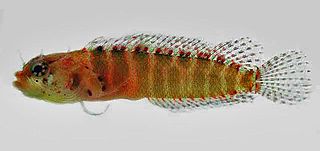
Starksia hassi, the ringed blenny, is a species of labrisomid blenny native to the Caribbean Sea and the Atlantic Ocean. It is and inhabitant of coral reefs and can be found at depths of from 6 to 175 m. This species can reach a length of 4 cm (1.6 in) TL.

Starksia langi, the Lang's blenny, is a species of labrisomid blenny native to the Caribbean coast of Central America, found in Belize, Honduras, and Panama. It is found in shallow waters of usually 3 m (9.8 ft) or less. This species reach a length of 1.7 cm (0.67 in) SL. It is named after Michael A. Lang, Director of the Smithsonian Marine Science Network and Smithsonian Science Diving Program. It is a prey of the lionfish.

Starksia lepicoelia, known commonly as the blackcheek blenny, is a species of labrisomid blenny native to the Caribbean Sea and adjacent Atlantic Ocean. It inhabits coral reefs and can be found at depths of from 8 to 20 m. This species can reach a length of 3.4 cm (1.3 in) TL.
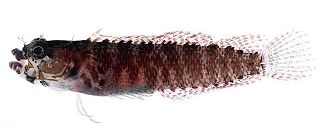
Starksia leucovitta, the whitesaddle blenny, is a species of labrisomid blenny only known to occur on the reefs around Navassa Island in the Caribbean Sea where it can be found from near the surface to a depth of 30 m (98 ft). This species can reach a length of 2.5 cm (0.98 in) SL.
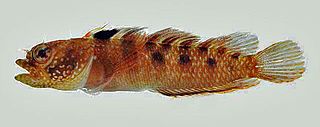
Starksia melasma, the black spot blenny, is a species of labrisomid blenny known only from reefs around Desecheo Island, Puerto Rico and St. Croix, U.S. Virgin Islands. This species can reach a length of 2.1 cm (0.83 in).
Starksia multilepis, the manyscaled blenny, is a species of labrisomid blenny only known from reefs of the Atol das Rocas and Fernando de Noronha Island off the coast of Brazil where it is found at depths of about 1 m (3.3 ft). This species can reach a length of 2.2 cm (0.87 in) SL.
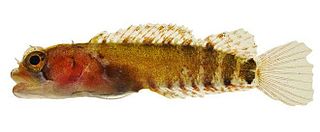
Starksia nanodes, the dwarf blenny, is a species of labrisomid blenny native to coral reefs of the Caribbean Sea and the adjacent Atlantic Ocean. This species can reach a length of 2.2 cm (0.87 in) SL.

Starksia ocellata, the checkered blenny, is a species of labrisomid blenny native to the Atlantic Ocean and the Caribbean Sea from North Carolina, United States, to Brazil. This species is an inhabitant of reefs at depths of from 2 to 20 m and can often be found living inside of tube sponges. It can reach a length of 6 cm (2.4 in) TL. It can also be found in the aquarium trade.

Starksia sangreyae, the Sangrey's blenny, is a species of labrisomid blenny native to the Caribbean coasts of Belize and probably also Honduras where it is found in shallow waters at depths of from 1 to 2 m. It was originally known as Starksia atlantica, and is also closely related to Starksia springeri. The species is named after Mary Sangrey, a scientist from Smithsonian Institution. This species can reach a length of 1.6 cm (0.63 in) SL.

Starksia sluiteri, the chessboard blenny, is a species of labrisomid blenny native to the Caribbean Sea and the Atlantic Ocean along the coast of Brazil including Atol das Rocas and St. Paul's Rocks. This species is an inhabitant of reefs where it prefers areas with rubble or crevices in which to hide. It can be found at depths of from 5 to 40 m. This species can reach a length of 2.8 cm (1.1 in) SL. The specific name honours the Dutch biologist and anatomist Carel Philip Sluiter (1854-1933), a specialist in tunicates.

Starksia springeri, the Springer's blenny, is a species of labrisomid blenny endemic to the waters around Curaçao where it is found at depths of from 1 to 25 m. It was originally known as Starksia atlantica, and is also closely related to Starksia sangreyae. The species is named after Victor G. Springer, a scientist from Smithsonian Institution. Males can reach a length of 1.5 centimetres (0.59 in) SL while females grow to 1.9 cm (0.75 in).

Starksia weigti, the Weigt's blenny, is a species of labrisomid blenny known only from the Caribbean coastal waters of Belize at depths of from 6 to 8 metres. It was previously known as Starksia lepicoelia, and is also closely related to Starksia williamsi and Starksia robertsoni. It is named after Lee A. Weigt, head of the Smithsonian's Laboratories of Analytical Biology. Males of this species can reach a length of 2.4 cm (0.94 in) SL While females reach 1.9 cm (0.75 in). >

Starksia williamsi, the Williams's blenny is a species of labrisomid blenny known only from the Saba Bank in the Netherlands Antilles where it occurs at depths of from 15 to 28 m. It was previously known as Starksia lepicoelia, and is also closely related to Starksia weigti and Starksia robertsoni. It was named after Jeffrey T. Williams, a scientist from Smithsonian's National Museum of Natural History known for his work on Starksia. This species can reach a length of 2.1 cm (0.83 in). The specific name honours the ichthyologist Jeffrey T. Williams of the National Museum of Natural History who has worked extensively on the blenniiform fishes.
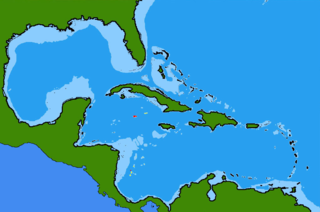
Starksia y-lineata, the forked bar blenny, is a species of labrisomid blenny native to reef environments of the Caribbean Sea. This species can reach a length of 1.9 cm (0.75 in) SL.






















